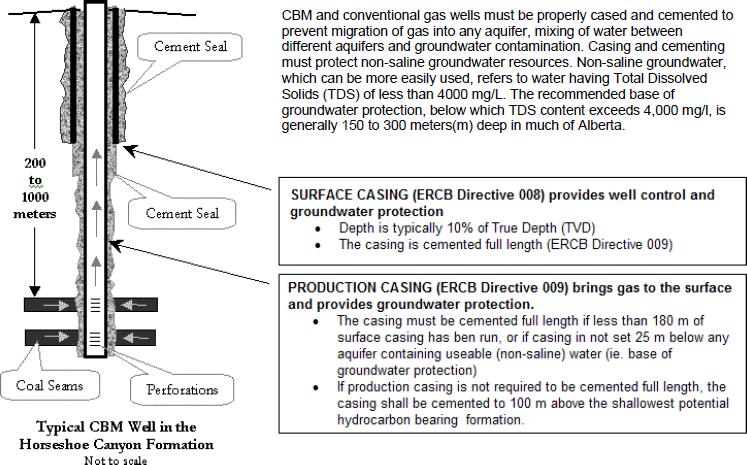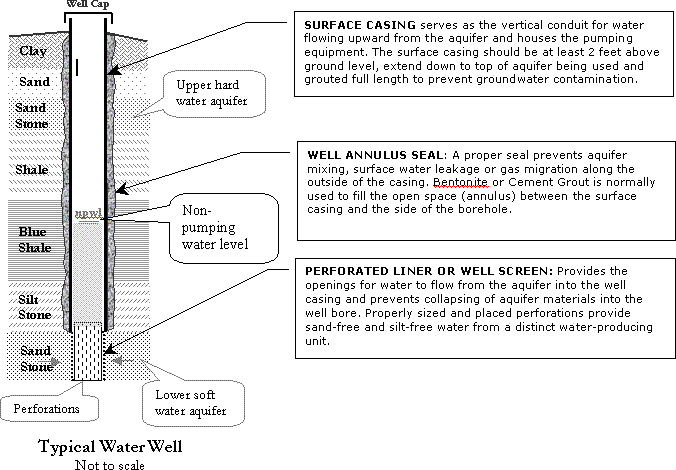| |
Coal Bed Methane (CBM) Wells & Water Well Protection | |
| |
|
|
| |
|
|
| | 
CBM Well Information and Alberta Energy Regulator Directives (previously ERCB Directives) are available on AER's website. Look under Rules and Directives to view an online copy. AER Directives that may be of particular interest to water well owners are 008, 009, 035, and 083.
Water wells to be drilled deeper than 150m require an ERCB well license.
Many of Alberta’s water wells naturally contain methane already. Methane is a tasteless and odourless gas that can cause spurting taps and gas locked pumps. Trapped methane in well pits or pump houses can explode. Therefore, proper venting and safety precautions are essential to prevent injury.
Measures You Can Take to Protect Your Water Well
It is important to monitor your water wells on a regular basis, especially before seismic and oil/gas drilling activities start. Pay attention to the following details:
| 1. | Water Well Site and Well Condition. Make sure that the area around your well is protected from contamination and the water well casing is in good condition. |
| 2. | Water Quality. Have a routine chemical and microbiological analysis done on the well water through an accredited laboratory. Methane tests are not part of a routine or microbiological analysis. |
| 3. | Well Production. Have repeatable pump tests done on your water well before and after oil and gas activity takes place. This is not a test of how hard your well can be pumped as the pumping rate should be less than actual well capacity. The pre-test and post-test must be done using identical test procedures. Pumping must be done at a constant rate and water level measurements recorded at specified time intervals during both the pumping and recovery cycles. Recovery time should be equal to pumping time. |
| 4. | Static or Non-Pumping Water Level (NPWL). Accurate measurement on a regular basis is important so that you know if your aquifer is depleting or being sustained. |
Proper Water Well Construction Can Protect Water Quality

More water well information is available in the publication "Water Wells That Last" or call 1-800-292-5697 (toll free) for a printed version.
Groundwater Risks
- Know and record where existing water wells are located on your property. Obtain well construction details and water quality information where possible. Alberta Environment maintains well records on their ground water information system. Visit Alberta Environment or phone the Groundwater Information Center at (780) 427-2770 or online at Alberta Water Well Information Database.
- Make sure your new water well is constructed in a manner that protects groundwater quality.
- Case the borehole down to the top of the aquifer that is being used. This prevents surface water contamination, water loss from one aquifer to another, gas migration, and aquifer mixing.
- Seal the space (annulus), between the casing and the side of the borehole with an appropriate grouting material from the top of the producing aquifer up to ground surface.
- The production zone of the water well should take water from only one distinct water-producing unit. Multiple aquifer well completions can cause gas and water migration between aquifers.
- Properly decommission old water wells and well pits. Many older wells are not adequately constructed to prevent contamination and mixing of water from different aquifers. The risk of contamination and mixing problems is increasing as old well casings corrode and rust out.
More Information
Alberta Agriculture and Forestry agricultural water specialists can be contacted toll free
through the Alberta Ag-Info Centre at 310-FARM(3276)
Prepared by
Alberta Agriculture and Forestry |
|
| |
|
|
| |
For more information about the content of this document, contact Murray Tenove.
This document is maintained by Deb Sutton.
This information published to the web on March 30, 2005.
Last Reviewed/Revised on May 18, 2018.
|
|